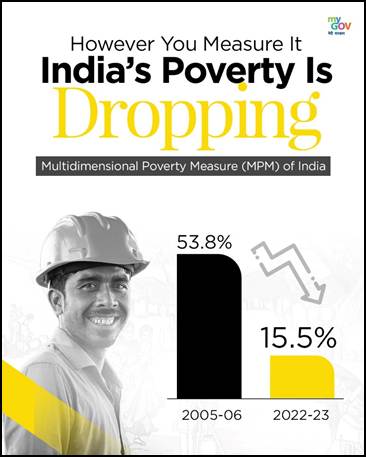India’s Decade of Progress in Poverty Reduction

- 01 May 2025
In News:
The World Bank’s Spring 2025 Poverty and Equity Brief has lauded India for lifting 171 million people out of extreme poverty between 2011-12 and 2022-23, reducing the poverty rate from 16.2% to 2.3%. This achievement underscores India’s sustained commitment to inclusive development, driven by economic growth, targeted welfare interventions, and improved access to essential services.
Key Findings:
The Poverty and Equity Briefs (PEBs), published biannually by the World Bank, assess poverty trends using international benchmarks (USD 2.15/day for extreme poverty, USD 3.65/day for lower-middle-income poverty), and include multidimensional poverty indicators and Gini Index estimates for income inequality.
- Rural and Urban Progress:
- Rural extreme poverty declined from 18.4% to 2.8%.
- Urban extreme poverty fell from 10.7% to 1.1%.
- The rural-urban poverty gap narrowed significantly, indicating more balanced regional development.
- Lower-Middle-Income Poverty (USD 3.65/day line):
- National poverty fell from 61.8% to 28.1%, lifting 378 million people out of poverty.
- Rural poverty declined from 69% to 32.5%, and urban from 43.5% to 17.2%.
- State-wise Contribution:Uttar Pradesh, Maharashtra, Bihar, West Bengal, and Madhya Pradesh—accounting for 65% of India’s poor in 2011—contributed two-thirds of the total poverty reduction by 2022-23.
- Multidimensional Poverty:
- MPI fell from 53.8% (2005-06) to 16.4% (2019-21).
- By 2022-23, it further reduced to 15.5%, indicating improvements in health, education, and living standards.
- Income Inequality:India’s Gini Index improved from 28.8 to 25.5, signaling a modest reduction in income disparities.
Employment and Structural Shifts
Employment growth has been robust post-2021:
- Female employment has increased, though still only 31%, with a 234 million gender gap in paid work.
- Urban unemployment declined to 6.6% in Q1 FY24-25, the lowest since 2017-18.
- A shift from rural to urban employment was noted among men, while rural women increasingly engage in agricultural self-employment.
Persistent Social Challenges
Despite progress, several social challenges persist:
- Marginalized communities (SCs/STs) face limited access to quality education, healthcare, and formal jobs.
- Malnutrition and health disparities remain despite schemes like POSHAN Abhiyaan.
- Water and energy poverty still affect large segments—49.8% of rural households lack piped water (NFHS-5), and many still rely on biomass despite the Ujjwala Yojana.
- Mental poverty due to chronic stress, unemployment (29% among graduates), and social stigma hinders productivity.
- Environmental degradation from unsustainable resource use affects the poorest most, worsening poverty cycles.
Policy Recommendations
To build on this progress, India must:
- Strengthen affirmative action and welfare delivery (e.g., PMJDY, DDU-GKY, Aadhaar-based targeting).
- Promote gender equality through effective implementation of BetiBachaoBetiPadhao, SSY, and gender-inclusive job creation.
- Expand clean energy and water access via solar microgrids and the Jal Jeevan Mission.
- Scale up mental health services using ASHA workers and awareness campaigns.
Conclusion
India’s success in drastically reducing poverty—both monetary and multidimensional—demonstrates the impact of focused development policies. However, the path ahead requires deeper reforms targeting inequality, gender disparity, and service delivery inefficiencies to ensure sustained, inclusive growth.
